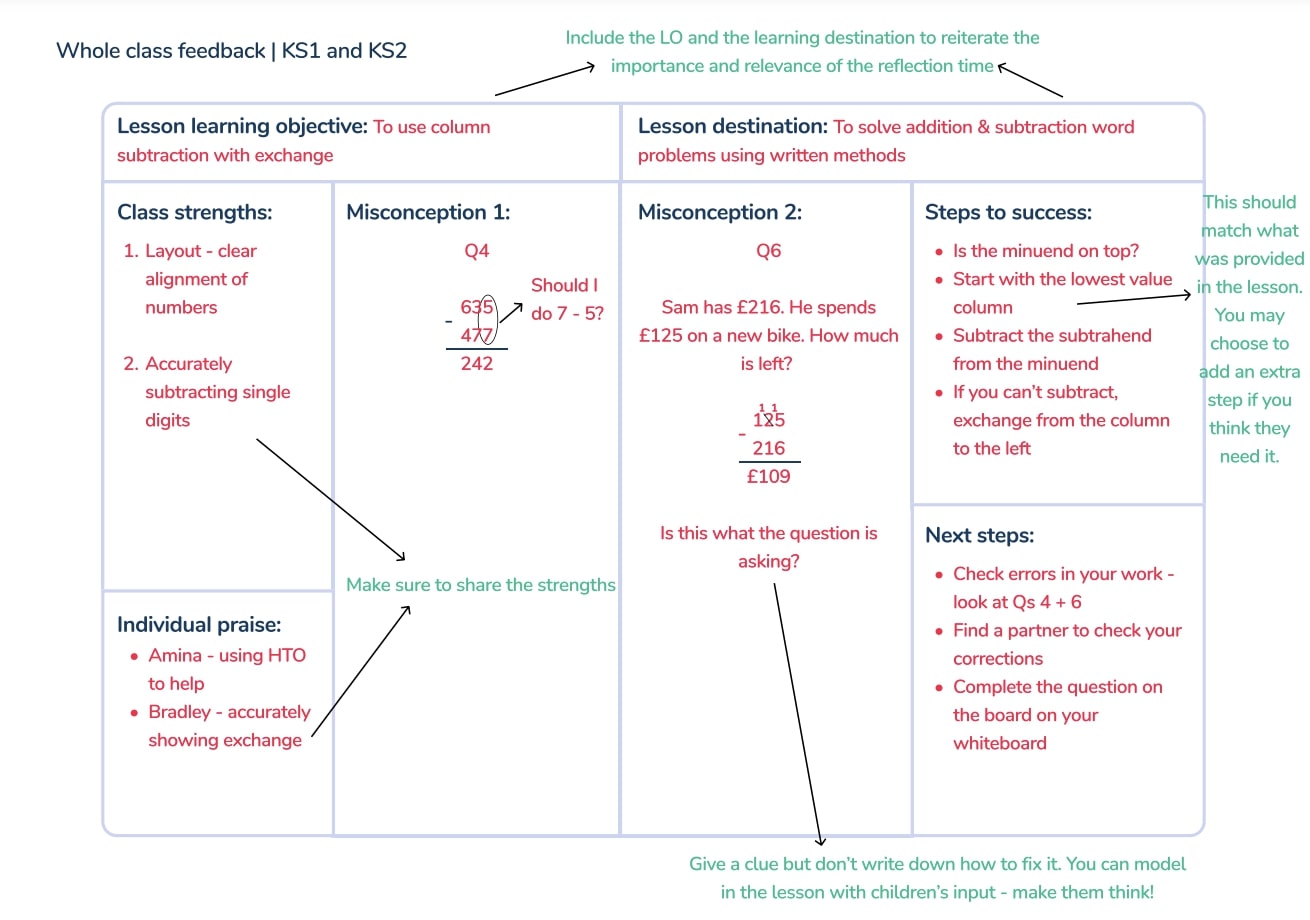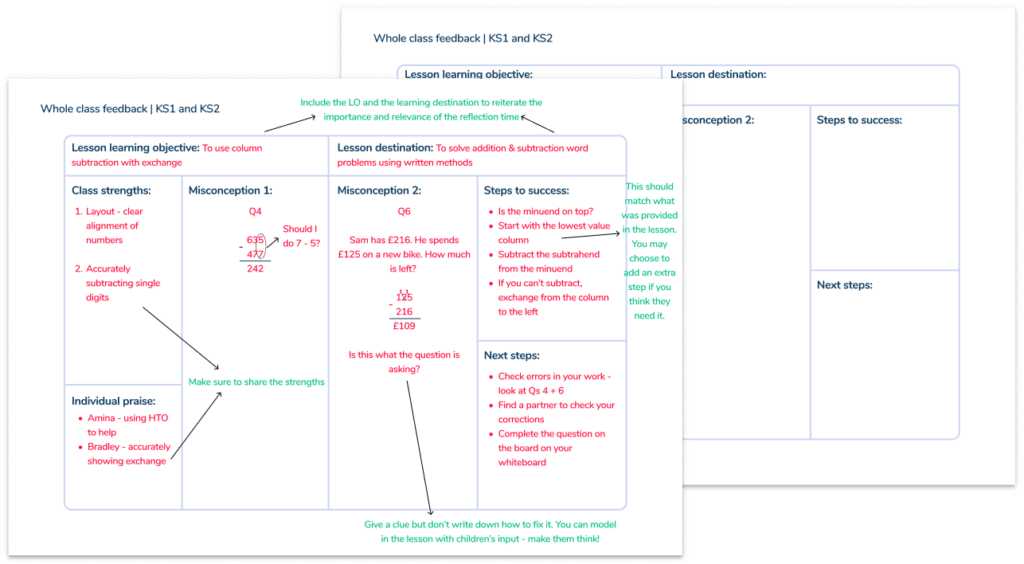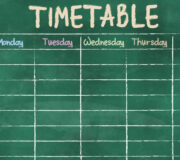Whole Class Feedback: How To Boost Learning In The Classroom [Includes FREE Template]
Whole class feedback (WCF) is one way in which you can improve the feedback process whilst reducing teacher workload.
In this blog we will explain how it can be an effective feedback tool and provide an example of how it can be used in maths. We have even included a downloadable feedback sheet for you to use in your classroom and an example of how to use it best.
What is whole class feedback?
Whole class feedback is a way for teachers to give feedback on student work without having to write individual comments in each student’s book. With WCF, the teacher reads through all the students’ work, makes a note of the things they did brilliantly and the areas where they could do with a bit of improvement and then shares this feedback with the entire class. The students then get the opportunity to respond to this feedback in their books, usually in the next lesson.
Whole Class Feedback Sheet Template & Example
Download this FREE whole class feedback template to improve your feedback process without adding to your workload
Download Free Now!Whole class feedback example
Let’s say the teacher’s objective in a lesson was to instruct the pupils on how to determine non-unit fractions of amounts. While conducting the lesson, the teacher might observe that a considerable number of students are struggling with dividing by the denominator and multiplying by the numerator.
Using WCF as a guide, the teacher will help the students by discussing the issue at the beginning of the next lesson. They will remind the students of the success criteria and provide them with an opportunity to correct their mistakes and answer a similar question again.
What are the benefits of whole class feedback?
There are several benefits to using WCF in class, including:
Reduces teacher workload
Rather than annotating each student’s book and writing time-consuming written comments, the teacher is able to reflect on common misconceptions and take notes on a single class feedback template.
Moves learning forwards
WCF encourages the teacher to assess learning in line with the destination. Rather than picking up on all small errors and writing wishy-washy comments, the teacher uses formative assessment to identify what needs to be addressed for learners to make progress in each unit of work.
Encourages children to reflect on their own work
By showing children what the common errors were at a whole class level, the onus is on them to identify where they may have gone wrong in their own piece of work. This encourages them to use the tools provided to fix it and helps embed children’s learning into their long-term memory.
Offers the opportunity to deepen learning
High quality WCF enables children to internalise the success criteria. Through identifying their own mistakes and applying the success criteria to different problems, children become more fluent in the steps to success. You can find out more about how this works in our blog on having a no marking policy.
5 common misconceptions about whole class feedback
Although WCF is a widely accepted feedback approach, there are still various misconceptions surrounding it.
1. Whole class feedback ignores some errors and misconceptions
There is concern that condensing up to 32 children’s work into one or two feedback points will overlook other errors and misconceptions. However, more marking does not equate to high quality, as children may not know what corrections to focus on, or may not bother reflecting on their work at all.
In an already tight teaching schedule, highlighting the most important misconceptions and giving children an opportunity to address these knowing it will help them move forwards will ensure time is used effectively. Other misconceptions can be addressed separately through individual/ small group interventions.
2. Whole class feedback is vague
As highlighted by Christodoulou, WCF runs the risk of providing the whole class time to reflect on vague comments that mean little to them e.g. ‘be more systematic’. Hence, it is paramount that effective feedback is accessible to children and makes them think.
Primary school pupils need effective modelling of how to tackle a problem, followed by time to fix errors in their previous work and deepen their understanding through further examples.
3. Whole class feedback replaces other types of feedback
Though it can be a useful tool that seriously reduces teacher workload, WCF should not be used in isolation.
In order to pick up small errors and provide tailored support, live marking should be used throughout lesson time to ensure learning is moving in the right direction. In doing so, teachers may find opportunities for on the spot whole class feedback (or mini-plenaries) where common issues keep arising.
4. Whole class feedback lowers ability children and children with SEND are disadvantaged
Of course, in any classroom there will be some children who need additional support to access their learning and may struggle to think critically. Therefore, as per the previous point, WCF is not an approach that can be used in isolation. Some children will need individual feedback if they are working at a significantly different level.
This is where adaptive teaching comes in; don’t be afraid to have a temporary reshuffle of groups during feedback sessions to ensure certain children have access to adult support. Effective deployment of teaching assistants in class can also have a very positive impact for these children.
5. Whole class feedback is just another fad
We have all sat in CPD sessions during our teaching careers and have wondered if a new approach you are being encouraged to use is really going to stick or if it will fizzle out by the end of the school year. Implemented properly, without too much rigidity, WCF can create lasting change.
You may need a different feedback template for different subjects. You may need to adapt how you share the feedback depending on the misconception. You may find that what works for one class, doesn’t for another.
Whole class feedback should not be a process of sticking a one-size fits all comment sheet into everyone’s books – instead, it is essential to focus on how pupils can progress with their learning by reflecting on misconceptions.
How to implement whole class feedback
Whole class feedback has been packaged differently depending on who is writing, but ultimately it requires the following 3 steps:
Step 1: Identify misconceptions and praise
Following a lesson, you should read through all the children’s books, identify any recurring misconceptions and note them down on a whole class feedback template – you can download our whole class feedback template for free here!
This template should include your lesson’s learning objective to ensure that the feedback is related to it. It should also include your ultimate learning destination to show children where they are heading towards by responding to your feedback.
In the main body of the template, you should include space for praise. You might just jot down a name and a quick note of what they did as a reminder to share with the class in the following lesson.
For example, you may praise a child for writing place value headings above their column subtraction problem, keeping the calculation organised and accurate. Other areas for praise may be in some of their mathematical explanations or, if in KS1, aspects such as writing numbers round the right way or presenting work as instructed.
Most importantly, you should also include one or two of the most critical misconceptions noticed across the class. On the same feedback sheet, you can write down the steps to success (which should align with what was taught in the lesson) so that the students can use this to make their corrections.

Step 2: Plan how you will share feedback
After reflecting on the misconceptions the children made, you need to plan how you are going to share your feedback and direct children during their reflection time. You may include this information on a slide at the start of the lesson or prepare a separate sheet of questions for the pupils.
As whole class feedback is rooted in ensuring individual students reflect on their own work, you may first direct children to check their own work for errors. For instance, you could ask all children to check their answer for the given question. If they have made the error identified by you they can try again, ideally in a different colour pen or pencil.
Following this, you may present them with similar questions to practise using the success criteria again, and you can challenge them even further with reasoning or problem solving questions. For example, you could ask them to correct a fictional child’s mistakes.
In some lessons, this may be a short starter activity. However, if the misconception needs more attention, it may be necessary to dedicate more time to it. As a result, you should consider the sequencing of future lessons in the unit.
Stuck for questions? Third Space Learning provides numerous free resources for you to use in your classroom.
Step 3: Address the classroom
The final step in WCF passes the onus from the teacher to the pupil.
First, the teacher needs to share their feedback with the class. This could be in the first lesson slide – with notes either typed up or scanned in. Alternatively, you may choose to share your notes under a visualiser. A visualiser can be an efficient way to share good examples of children’s work that you noted down on the feedback sheet.
During this teacher-led discussion, it is important to model to pupils how to use the success criteria to overcome the misconception. This then enables them to review their own answers either independently or with a partner.
By recording this in another colour, it is clear to the teacher whether the child has applied the feedback or not. Once their corrections have been addressed, the ‘next steps’ section of the feedback sheet will direct them to the aforementioned extension questions to embed their knowledge further. This may be done in their books or alternatively on a mini-whiteboard.

Tips for teachers to implement whole class feedback successfully
Here are some tips for teachers to maximise the effectiveness of whole class feedback:
1. Define your learning goal for feedback
There is no point in dedicating whole class feedback to something indirectly related to the learning objective. For example, a handful of arithmetic errors should not be the focus of column subtraction feedback if the learning objective was to use exchanging.
In contrast, if the long-term goal is for children to solve word problems but their understanding of how to extract information from these questions is not robust, this could be incorporated into your feedback sheet.
2. Consider your success criteria
To help children internalise a process, it is essential that the steps are laid out clearly and consistently. The success criteria first taught in the lesson should also double up as a way for them to diagnose their mistakes.
3. Be flexible in your approach
WCF is not one size fits all approach and no lesson will be – or should be – the same. Sometimes just a short feedback session is required, whereas other times you may want to spend more time addressing misconceptions before moving learning forward.
4. Keep it simple
If you search for whole class feedback sheets online, you will find a number of beautifully presented crib sheets. However, these can sometimes overcomplicate the process. If you can’t work out what should go in each box, you cannot expect the children in your class to know how to read it.
5. Choose a feedback method that works for you
We all have different teaching styles and what comes naturally to one teacher may feel alien to another.
Whether you prefer using a visualiser, having it scanned in on slides or keeping it more paper based, do what works for you and your class. As long as the feedback is explained to the children and they have the opportunity to respond, you are on the way to high quality WCF.
Yes – but it is essential that it is thought through and structured to support children to overcome misconceptions and move learning forwards. By following the steps of identify, plan, address, the children in your class will be able to deepen their understanding whilst significantly reducing your workload.
Yes – but it is essential that it is thought through and structured to support children to overcome misconceptions and move learning forwards. By following the steps of identify, plan, address, the children in your class will be able to deepen their understanding whilst significantly reducing your workload.
When used effectively, whole class feedback can significantly reduce teacher workload by stripping feedback down to the bare minimum. This simultaneously benefits the pupil as feedback is focussed on moving their learning forwards and puts the onus on them to apply what has been signposted to them.
DO YOU HAVE STUDENTS WHO NEED MORE SUPPORT IN MATHS?
Every week Third Space Learning’s maths specialist tutors support thousands of students across hundreds of schools with weekly maths tuition designed to plug gaps and boost progress.
Since 2013 these personalised one to one lessons have helped over 150,000 primary and secondary students become more confident, able mathematicians.
Learn how we can teach multiple pupils at once or request a personalised quote for your school to speak to us about your school’s needs and how we can help.





